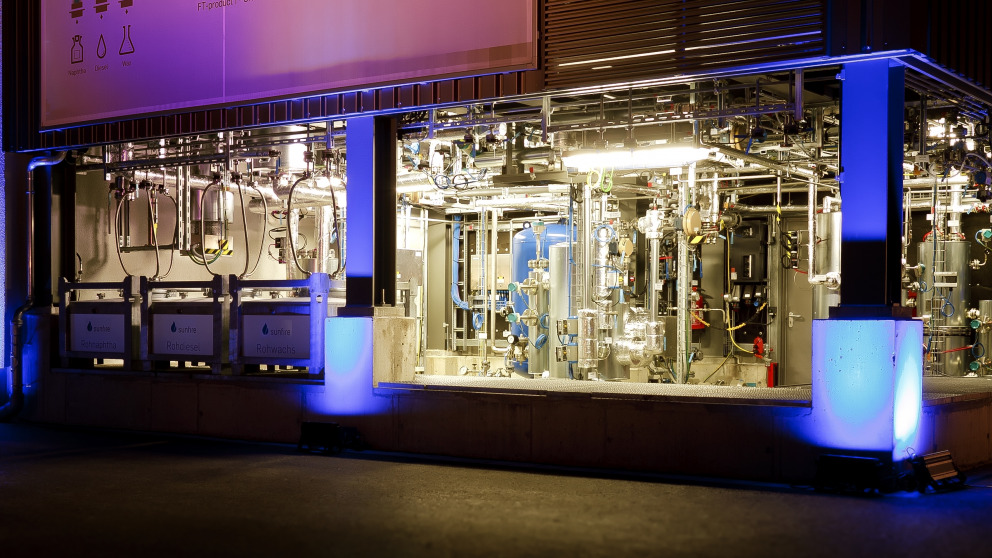CO2 Recycling: Large Potential but Many Uncertainties Remain
31.05.2019
Many different technologies already exist for converting the greenhouse gas carbon dioxide (CO2) into products like construction materials and chemicals. But which of them can make a real contribution to climate protection? A new study commissioned by the European Commission provides answers.
In the study, the IASS and its research partners conclude that many Carbon Capture and Utilisation (CCU) technologies have the potential to reduce the use of other fossil resources. In this way, they can broaden the raw material base while also helping to protect natural resources and reduce emissions. However, the high energy requirements of many of these technologies mean that they too are a source of greenhouse gas emissions.
Bound once – but not for all
The IASS team calculated how much CO2 the most promising technologies could bind in Europe under ideal conditions. That quantity does not, however, translate into an equivalent reduction in CO2 emissions, since all of the conversion technologies require energy.
The study shows that in theory, the 15 most promising technologies could bind 1,928 million tons of CO2 every year. But this estimate reflects the best-case scenario. To put it into perspective: in 2016, the 28 EU states emitted a total of 4,291 million tons of greenhouse gases in carbon dioxide equivalents.
Methane und synthetic fuels could bind large quantities of CO2
Given its high production and import volume and its relatively high CO2-binding capacity, methane has the potential to bind the most CO2. Assuming an ideal market situation and optimal technical conditions, the production of methane could bind 1,008 tons of CO2 annually in the EU. Methane is used directly as a heating gas and a starting product in the chemical industry. About three quarters of the methane used in Europe is imported. So in the longer term, more widespread application of CCU technologies could lead to greater independence from imports of fossil resources.
Synthetic fuels generated in CCU processes also have a potentially large CO2-binding capacity: in theory, they could bind 525 million tons of CO2 annually in the EU. However, they are not yet a cost-competitive alternative since they are still more expensive than fossil fuels like petrol. There is another drawback: in the case of both methane and synthetic fuels, the bound CO2 is released back into the atmosphere within a relatively short time, since both substances are used mainly as transport fuels.
Lifecycle analysis needed for every product
Barbara Olfe-Kräutlein (IASS), a co-author of the study, emphasises that more research is needed to fully understand the environmental impacts of the various CCU processes: “In order to quantify the ecological benefits of a particular CCU technology, we need not only data on the theoretical CO2-binding capacity, but also an analysis of the environmental impacts of a given product over its entire lifecycle. This is easier in the case of CCU products that are identical to conventional ones, because the use and disposal are the same in both cases and the analysis can thus focus on the production process.”
The study was commissioned by the Directorate General for Climate Action at the European Commission. The aim was to identify and evaluate the CCU technologies that should be supported by the planned EU Innovation Fund. The Fund will use auctioning proceeds from the EU Emissions Trading Scheme to promote innovative climate change technologies in industry and power generation across the EU. Work on the study was coordinated by Ramboll. The IASS was responsible for the first part of the study, which analyses the different technologies and their possible societal impacts.
Publication:
Turnau, S., Jaspers, D., Marxen, A., Naims, H., de Bruyn, S., Bringezu, S., Kaiser, S., Gimnes Jarøy, A., Porteron, S., Ombudstvedt, I., Ellingsen Gran, M., Le Den, X., Zotz, F., Olfe-Kräutlein, B., Bruijne, E. d. (2019): Identification and analysis of promising carbon capture and utilisation technologies, including the regulatory aspects thereof. Final report, Luxemburg: European Union, Publications Office, 298 p.
DOI: http://doi.org/10.2834/348288
